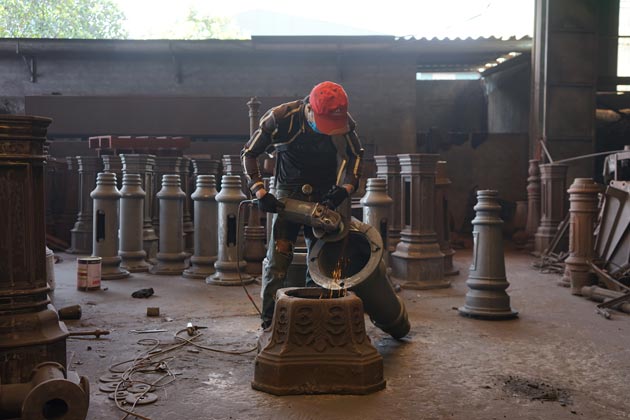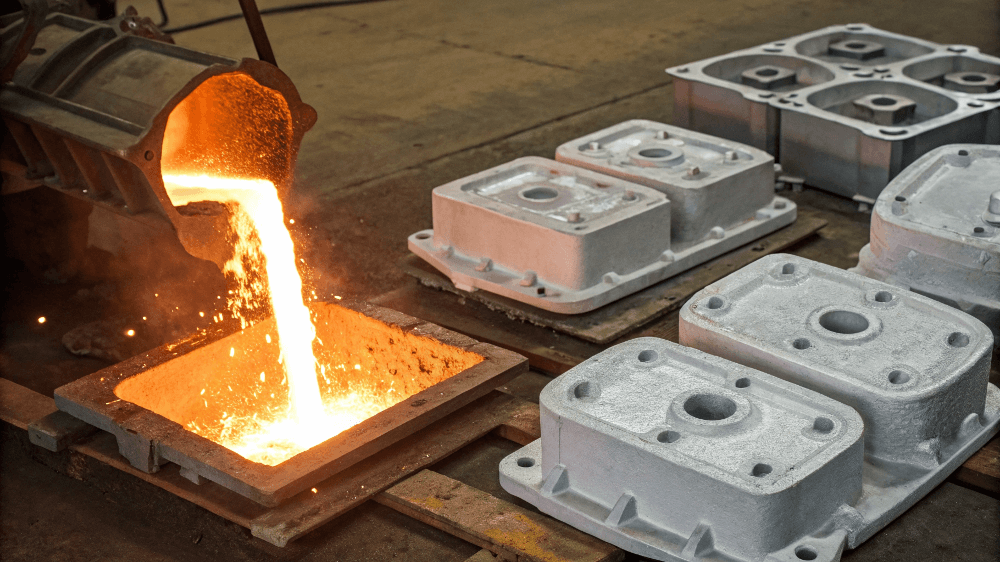Discovering what makes Aluminum Foundry Wisconsin beneficial in casting
Exactly How Aluminum Foundry Contributes to Advancements in Aerospace Design
Aluminum shops are indispensable to innovations in aerospace design. They generate lightweight, high-strength parts that are crucial for contemporary airplane. Through sophisticated spreading methods, these foundries produce intricate geometries that improve architectural honesty. In addition, the advancement of remarkable Aluminum alloys sustains the sector's focus on fuel performance and sustainability. Obstacles continue to be in the manufacturing process. Recognizing these variables reveals the extensive influence of Aluminum on aviation's future.
The Significance of Lightweight Materials in Aerospace Style
As the aerospace sector remains to advance, the value of lightweight materials comes to be significantly apparent. The need for effectiveness and sustainability drives designers to focus on the usage of products that minimize general weight without compromising structural integrity. Lightweight materials, especially Aluminum, play an essential role in improving gas performance, boosting haul capability, and increasing the overall performance of airplane.
The combination of these products enables for ingenious styles, enabling producers to create even more aerodynamic forms that can withstand extreme conditions. The reduction in weight not just lowers operational costs however likewise contributes to a reduced environmental footprint, straightening with global initiatives toward sustainability in air travel.
Advanced Spreading Techniques in Aluminum Foundries
Advanced casting strategies in Aluminum factories play an important role in aerospace design by allowing the production of light-weight and specific parts. Technologies in mold design and precision spreading processes are crucial in attaining suitable efficiency and structural honesty. Furthermore, the development of light-weight alloys boosts the total effectiveness and effectiveness of aerospace applications.
Innovative Mold And Mildew Design
Innovative mold style plays an important duty in the efficiency and performance of Aluminum foundries, especially within the aerospace industry. By leveraging innovative materials and methods, modern-day molds can be crafted to hold up against heats and stress, guaranteeing peak efficiency during the casting procedure. These designs frequently integrate complex geometries that permit the manufacturing of light-weight yet structurally audio parts, necessary for aerospace applications. In addition, making use of computer-aided layout (CAD) software program promotes specific modeling, enabling foundries to replicate and improve mold designs prior to physical manufacturing starts. This not only enhances the high quality of actors components but likewise minimizes waste and lead times, causing substantial cost financial savings. Overall, ingenious mold and mildew style is a cornerstone of development in Aluminum Foundry innovation for aerospace design.
Accuracy Casting Procedures
The efficiency of innovative mold and mildew layouts flawlessly incorporates with precision casting processes, which are essential for producing high-quality Aluminum parts in aerospace design. These procedures, consisting of sand casting, die spreading, and financial investment spreading, guarantee the creation of complex geometries with tight resistances. Advanced strategies like vacuum cleaner casting and stress pass away casting improve the stability and surface coating of the final products. Precision casting decreases product waste while taking full advantage of the mechanical properties of Aluminum, vital for aerospace applications. Furthermore, utilizing real-time monitoring and advanced simulation devices during the spreading process permits for prompt modifications, resulting in enhanced quality assurance. Collectively, these accuracy casting procedures setting Aluminum foundries at the center of aerospace advancement, supporting the sector's need for dependability and performance.
Lightweight Alloy Growth
As aerospace engineers look for to boost gas performance and performance, light-weight alloy growth ends up being a crucial focus in Aluminum shops. These foundries employ innovative casting methods to create alloys that supply exceptional strength-to-weight proportions. Advancements in alloy composition, including the consolidation of components like lithium and magnesium, allow the production of products that endure severe conditions while minimizing overall aircraft weight. Techniques such as die spreading and financial investment casting promote the accuracy manufacturing of intricate shapes, which are crucial for aerospace applications. Additionally, recurring research intends to maximize these alloys for improved mechanical residential or commercial properties and boosted sturdiness. By prioritizing lightweight alloy growth, Aluminum shops substantially add to the evolution of aerospace engineering, leading the way for extra lasting and reliable airplane designs.

Enhancing Architectural Integrity With Aluminum Components
Aluminum parts supply substantial advantages in improving structural honesty within aerospace design. Their lightweight nature adds to general effectiveness while maintaining toughness, which is essential for airplane efficiency. Furthermore, the stress and anxiety resistance residential or commercial properties of Aluminum assistance ensure the longevity and integrity of aerospace frameworks under different operational problems.
Lightweight Material Conveniences
While standard materials often endanger weight for stamina, utilizing Aluminum parts in aerospace design offers substantial advantages in architectural honesty. Aluminum's lightweight nature adds to total style effectiveness, permitting even more streamlined aircraft that eat less gas, thereby enhancing sustainability. The product's excellent strength-to-weight proportion guarantees that parts preserve resilience without including unneeded mass. This quality cultivates enhanced efficiency and agility in trip, as well as enhanced haul abilities. Additionally, Aluminum's resistance to rust prolongs the lifespan of aerospace frameworks, decreasing maintenance prices and enhancing safety and security. As suppliers significantly take on Aluminum alloys, the aerospace market experiences a transformative change towards a lot more efficient and efficient engineering remedies that prioritize both efficiency and ecological duty.
Stress And Anxiety Resistance Qualities
Although numerous products have one-of-a-kind buildings, Aluminum's exceptional anxiety resistance attracts attention as an important factor in boosting the structural stability of aerospace elements. This resistance plays an important function in guaranteeing that aircraft can stand up to different functional tensions, including fatigue, impact, and environmental problems. Aluminum alloys, especially engineered for aerospace applications, display high tensile toughness while keeping light-weight attributes, allowing engineers to develop much more reliable frameworks - Aluminum Foundry. Furthermore, the capacity of Aluminum to withstand cyclic loading without considerable deformation adds to the durability and reliability of aerospace elements. As improvements continue in Aluminum Foundry strategies, the growth of stress-resistant Aluminum elements guarantees more renovations in performance, safety, and performance across the aerospace market, solidifying Aluminum's function as a preferred product in contemporary engineering
Gas Efficiency Improvements Driven by Aluminum Innovations
As the aerospace industry looks for to enhance gas efficiency, cutting-edge usages of Aluminum have actually emerged as a necessary go service. Aluminum's light-weight nature significantly reduces aircraft weight, permitting reduced fuel intake during trip. This reduction in weight is essential, as even little declines can result in substantial enhancements in overall gas economic climate.
Advanced Aluminum alloys, designed for improved stamina and sturdiness, make it possible for manufacturers to create elements that preserve architectural stability while decreasing mass - Aluminum Foundry. Additionally, the assimilation of Aluminum in airframes and engine components promotes improved aerodynamics, contributing to lowered drag and enhanced efficiency
The adoption of Aluminum in aerospace not only fulfills the need for fuel-efficient style yet additionally aligns with governing stress for reduced emissions. As these technologies proceed to evolve, they play a substantial duty in establishing brand-new standards for gas efficiency, guaranteeing that the aerospace field can fulfill expanding financial and ecological obstacles.

The Role of Aluminum in Sustainable Aeronautics Practices
The boosting emphasis on lasting aviation practices has actually placed Aluminum you can check here as an essential material in the mission for greener airplane layout. Known for its lightweight residential properties, Aluminum significantly decreases aircraft weight, leading to reduced gas usage and exhausts. Its recyclability additionally improves its sustainability account, as Aluminum can be reused indefinitely without loss of quality. This characteristic supports a round economy within the air travel industry, minimizing waste and resource deficiency.
Advancements in Aluminum alloys have improved their stamina and rust resistance, allowing for longer service life and decreased maintenance demands. These advancements facilitate the growth of much more efficient aircraft structures, adding to general sustainability efforts. Additionally, Aluminum's thermal conductivity plays a crucial function in energy-efficient designs, enhancing systems such as warmth exchangers. Collectively, these features highlight Aluminum's crucial duty beforehand sustainable air travel, aligning with global campaigns focused on lowering the environmental impact of air traveling.
Obstacles Encountered by Aluminum Foundries in Aerospace Production
While Aluminum foundries play an important role in aerospace manufacturing, they face substantial challenges that can influence production efficiency and top quality. One significant difficulty is the strict quality assurance requirements needed in the aerospace market. Any kind of problem can jeopardize security and efficiency, requiring rigorous assessment procedures that extend manufacturing timelines. Furthermore, shops often contend with changing raw product prices, which can affect pricing and success. The complexity of Aluminum alloys utilized in aerospace applications additional makes complex the production procedure, as specific solutions are essential for achieving desired mechanical buildings. Furthermore, competent labor lacks hinder the ability to preserve high-grade production levels. Ecological laws enforce restrictions on emissions and waste management, calling for factories to invest in sustainable techniques, which can be cost-prohibitive. These factors jointly produce a landscape where Aluminum foundries have to constantly adapt to fulfill the advancing needs of aerospace production while guaranteeing safety and security and conformity.
Future Fads in Aluminum Applications for Aerospace Engineering
With innovations in modern technology and boosting needs for efficiency, the future of Aluminum applications in aerospace engineering read what he said is positioned for substantial improvement. The assimilation of ingenious Aluminum alloys and compounds is anticipated to enhance strength-to-weight ratios, causing even more fuel-efficient airplane designs. Furthermore, advancements in additive production strategies will enable the manufacturing of intricate Aluminum structures that were formerly impossible, enhancing performance and decreasing waste.

Sustainable methods will certainly play a crucial role, with an expanding emphasis on recycling Aluminum to minimize ecological impact. The aerospace market is most likely to accept smarter manufacturing procedures, such as automation and expert system, guaranteeing higher quality and precision in Aluminum components. In addition, collaborations between Aluminum foundries and aerospace business will cultivate r & d, leading the method for brand-new applications that fulfill the stringent requirements of modern-day aerospace design - Aluminum Foundry. On the whole, the future looks assuring for Aluminum's function in shaping the skies
Regularly Asked Concerns
What Are the Environmental Impacts of Aluminum Manufacturing in Aerospace?
The ecological effects of Aluminum production in aerospace include significant power usage, greenhouse gas emissions, and habitat disruption. Furthermore, mining processes can lead to dirt deterioration and water contamination, increasing problems concerning sustainability and environmental equilibrium.
Just How Does Aluminum Contrast to Various Other Materials in Aerospace Applications?
Aluminum uses a special combination of light-weight homes, corrosion resistance, and cost-effectiveness contrasted to other products. Its high strength-to-weight ratio makes it particularly useful for aerospace applications, improving gas effectiveness and total performance in aircraft design.
What Certifications Do Aluminum Foundry Workers Demand for Aerospace Projects?
Aluminum Foundry workers require customized training in metallurgy and casting strategies, in addition to expertise of aerospace sector criteria. Accreditations in quality assurance and safety and security protocols are also important to ensure conformity with rigorous aerospace project demands.
Exist Any Kind Of Safety And Security Interest In Utilizing Aluminum in Aerospace Engineering?
Safety and security issues regarding Aluminum in aerospace design include sensitivity to fatigue, rust, and stress and anxiety fractures. Appropriate treatment and alloy choice are vital to minimize these risks, guaranteeing structural honesty and total safety in aerospace applications.
Exactly How Does Aluminum Recycling Benefit the Aerospace Sector?
Aluminum recycling significantly benefits the aerospace market by minimizing material costs, minimizing environmental influence, and preserving energy. This sustainable technique boosts the industry's efficiency while advertising making use of lightweight, high-performance components in aircraft production.
Advanced spreading techniques in Aluminum factories play a critical role in aerospace design by making it possible for the production of lightweight and precise parts. Ingenious mold and mildew layout plays an essential duty in the efficiency and effectiveness of Aluminum foundries, particularly within the aerospace market. As aerospace engineers seek to improve fuel performance and efficiency, lightweight alloy advancement ends up being an essential focus in Aluminum shops. Aluminum alloys, particularly crafted for aerospace applications, display high tensile strength while preserving lightweight characteristics, enabling designers to create much more reliable structures. Collaborations in between Aluminum shops and aerospace companies will foster research study and advancement, paving the way for brand-new applications that fulfill the stringent requirements of contemporary aerospace design.